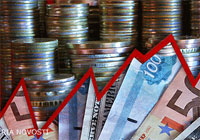Audit Chamber believes govt economic forecasts for 2014-2016 too optimistic

(Interfax – MOSCOW, June 3, 2013) Experts at the Audit Chamber and economists it recruited who work at government, corporate and research institutions are questioning the Russian government’s social and economic scenarios and forecasts for 2014-2016.
The social and economic development forecast that the government considered on May 16 was discussed on May 29 at a meeting at the Audit Chamber chaired by the fiscal watchdog’s deputy chairman Valery Goreglyad, the Chamber’s website reported.
Preceding the discussion, he stressed that the Audit Chamber as a matter of course considers the scenarios and forecasts that are the basis for the draft federal budget for the upcoming three years. “This is an integral part of the Audit Chamber’s conclusions on the budget bill. In preparing the conclusions, it is fundamentally important for us to consider the views of experts on how realistic the macro forecast and risks accompanying the implementation of the base scenario are,” Goreglyad said.
“The Audit Chamber has serious doubts about the tenability of the government’s choice of the moderately optimistic scenario as the base scenario for working out the parameters of the federal budget,” Goreglyad said.
He said the “government’s optimism rests on expectations of an improvement in the investment climate, the effect of the implementation of plans to modernize and increase the competitiveness of the economy, as well as an increase in the effectiveness of budget spending.”
“However, the scenario conditions and main forecast parameters do not even include a convincing analysis of the reasons for the slowdown of economic growth, let alone proposals to generate this positive internal factors that, according to the government’s premise, are supposed to play a decisive role in the implementation of the base scenario,” Goreglyad said.
He said the Audit Chamber’s monitoring shows that many government programs, even if they are being implemented then only nominally according to the approved plan of action; their actual results are quite modest and often far from initial expectations.
As an example, he cited the program to develop competition in Russia started in 2009. The plan of action, according to the Audit Chamber, was carried out at a rate of 88%, but the situation with competition did not improve. Then this program was stopped early, and in its place at the end of last year the government adopted a road map for the Development of Competition and Improvement of Antimonopoly Policy.
“If even in areas where specific programs have already been adopted and are being implemented it is difficult to achieve progress, then how is it possible to factor positive changes into the forecast without proposals to ensure such scenario conditions,” Goreglyad said.
He also noted that Russia has a sovereign credit rating of BBB from Fitch and S&P and Baa1 from Moody’s, but the government expects the country to secure the highest international credit ratings by 2016. “Hence the question, to what extent Russia’s current credit ratings limit the inflow of foreign investment and impede the implementation of the forecast scenario. Or are other factors hindering us?” Goreglyad said.
All the more so since the position of the government forecast for an improving investment climate contradicts statistics on net private capital outflows, which reached $26 billion in the first quarter of 2013, after topping $54 billion in 2012, he said.
“We are seeing an acceleration of outflows. But the basis version of the forecast assumes private capital outflow will decrease to zero in 2014 already. Here the government’s optimism borders on science fiction,” Goreglyad said. Moreover, he added, the combined investment programs of companies in the electricity, oil, gas and rail sectors have been reduced by more than 10% for 2013-2015.
Remarking that the base forecast assumes 2.4% GDP growth in 2013 and 3.7% in 2014, he said that following growth of just 1.7% in the first four months of this year the government is assuming, without any clear justification, that there will be an upturn in the second half to achieve the forecast growth of 2.4%. And it is not clear what will drive economic growth in 2014 to exceed that of this year and last year, he added.
The base scenario projects a slight weakening of the ruble amid a steady decline in the average oil price in 2014-2016, which should logically set the stage for an economic depression, Goreglyad said.
“However, the same base scenario, on the contrary, assumes higher GDP growth due to increased competitiveness of domestic products and the acceleration of import substitution processes. Furthermore, import substitution, according to government plans, will paradoxically increase amid growth of imports that they forecast will average 4% per year and an anticipated current account deficit of $10 billion by 2016,” Goreglyad said.
Even in the more pessimistic scenario based on an oil price of $80 per barrel, the Economic Development Ministry is forecasting GDP growth of 1% in 2014 and up to 2.9% in 2016. “Therefore, the government does not have a version of the forecast that would describe the conditions of the country entering into a recession or, consequently, a program of action in such a situation,” Goreglyad said.
“In general, the government’s optimism seems unjustified,” he said.
